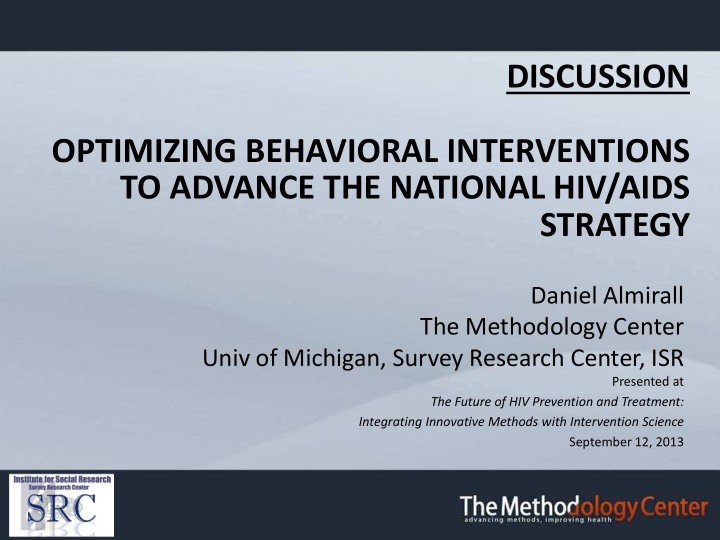



DISCUSSION OPTIMIZING BEHAVIORAL INTERVENTIONS TO ADVANCE THE NATIONAL HIV/AIDS STRATEGY Daniel Almirall The Methodology Center Univ of Michigan, Survey Research Center, ISR Presented at The Future of HIV Prevention and Treatment: Integrating Innovative Methods with Intervention Science September 12, 2013
Multi-component Behavioral Interventions (Treatment Packages) —Parts of intervention content • e.g.: topics in a school-based drug abuse/HIV prevention curriculum —Features that promote compliance/adherence • e.g.: regular home visits by nurse —Features aimed at improving fidelity • e.g.: 800 number for program delivery staff to call with questions 2
Consider a special type of Multi- component Behavioral Intervention where treatment components are individualized to the changing needs or specific circumstances of the individual over time. In what kinds of settings might this happen? 3
Examples where intervention components are individualized over time —Rescue treatments • e.g.: for children who are non-responders to medication for ADHD, augment treatment with behavioral modification —Maintenance treatments • e.g.: utilize a telephone disease management system for persons with alcoholism who remain abstinent after graduating from an intensive residential treatment program • e.g.: training parents to deliver a behavioral intervention for children with autism who respond well to therapist-delivered treatment 4
These types of interventions can be operationalized as Adaptive Interventions Sequence of individually-tailored decision rules • that specify whether, how or when • to alter the intensity, type, dosage, or delivery of treatment • at critical decision points in the course of care. Adaptive interventions serve as a guide for clinical practice. 5
A Concrete Example of an Adaptive Intervention in Child ADHD • Begin treatment on low-dose medication and monitor the child monthly for symptom improvements • IF , starting in month 3, the child fails to respond based on teacher ratings of the child’s impairment THEN augment medication with behavioral modification (a psychosocial intervention) • OTHERWISE IF the child continues to respond, THEN remain on low-dose medication. 6
A Concrete Example of an Adaptive Intervention in Child ADHD (in picture) 7
There are many questions when constructing a high-quality adaptive intervention • What is the best first-line treatment? • What is the best second-line treatment for early responders to first-line treatment? • What is the best second-line treatment for early non- responders to first-line treatment? • How do we define non-response? • Can we use adherence to first-line treatment to adapt second-stage treatment options? Stay tuned for tomorrow… 8
The National HIV/AIDS Strategy for the US 9
The National HIV/AIDS Strategy; Page 15 “ …there is no single ‘magic bullet’ that will stem the tide of new HIV infections. In the past, some have focused on one method of HIV prevention in favor of others. The public discourse has … led some to believe that a single solution, whether it is education, condom use, or biomedical innovations, held the key to reducing HIV infections. Our prevention efforts have been hampered by not deploying adequate overlapping, combination approaches to HIV prevention. Evaluating multiple scientifically proven methods will have a greater impact... Additional research can help identify … the most effective combination approaches to prevent new HIV infections.”
The National HIV/AIDS Strategy; Page 36 “ Being linked to care is not enough … as many as 30 percent of people diagnosed with HIV are not accessing care. There is a need to re-engage people diagnosed with HIV who have … subsequently fallen out of care. There is a need for ongoing support to maintain the necessary high levels of adherence to antiretroviral treatment. … Additionally, we need to better understand how to manage the clinical complications and consequences of HIV infection and long-term use of antiretroviral drugs— including issues related to accelerated heart disease, kidney disease, cancers, and premature aging.”
Recommend
More recommend